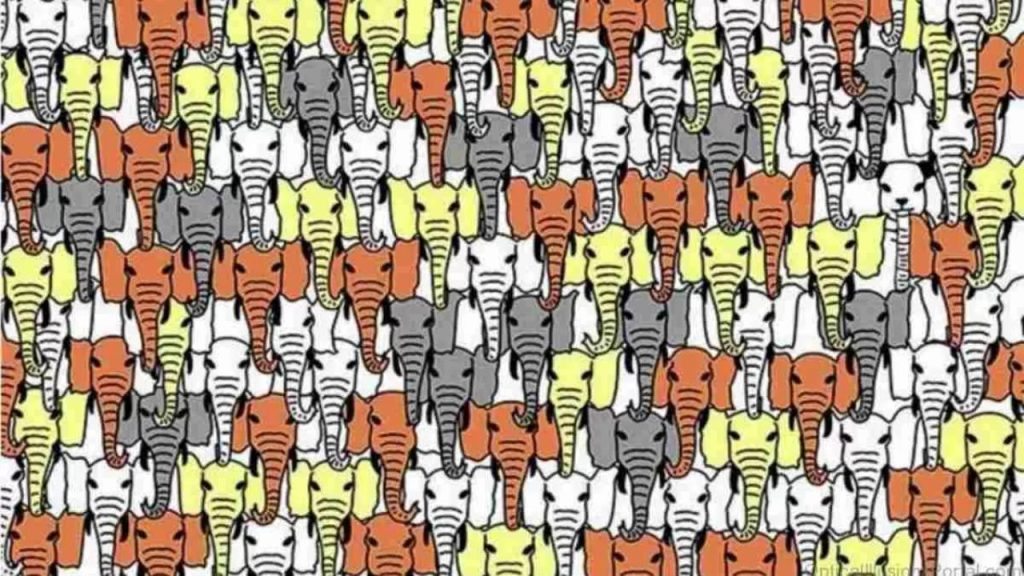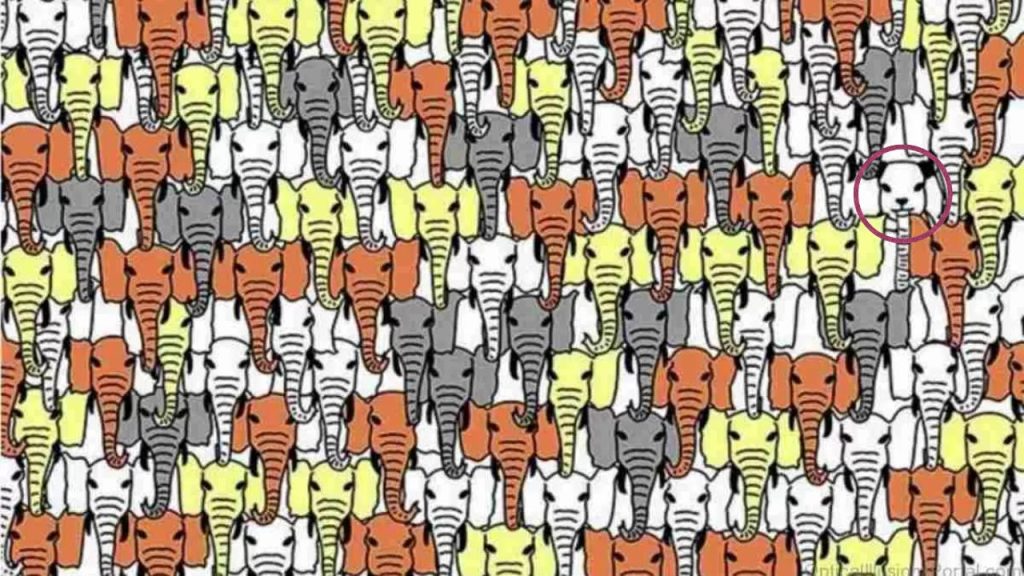The Fascinating World of Hidden Animal Puzzles
Visual puzzles featuring hidden animals have become incredibly popular across social media platforms and educational websites. These challenges tap into our natural curiosity while testing our ability to spot details that others might miss completely.
The panda puzzle represents one of the most challenging optical illusions circulating online today. Unlike simple spot-the-difference games, this test requires exceptional visual processing skills and keen attention to subtle details.

Why Pandas Make Perfect Hidden Objects
Pandas possess unique physical characteristics that make them ideal subjects for optical illusion puzzles. Their distinctive black and white coloring creates natural camouflage opportunities when placed among similar patterns.
Expert puzzle designers understand how panda markings can blend seamlessly with geometric shapes, text, or other visual elements. This natural camouflage effect makes the challenge significantly more difficult than it initially appears.
The Science of Visual Camouflage
Our brains process visual information through complex neural pathways that have evolved over millions of years. These systems work incredibly fast, making thousands of decisions about what we’re seeing in just seconds.
However, this speed sometimes works against us when dealing with carefully crafted illusions. Our visual system can be tricked into overlooking important details that don’t match our initial expectations.
Understanding Top-Tier Vision Capabilities
People with exceptional visual abilities possess several key characteristics that set them apart from average observers. These individuals can process complex visual information quickly while maintaining accuracy under pressure.
Research studies have shown that top-tier vision involves more than just good eyesight. It requires superior cognitive processing, pattern recognition, and the ability to ignore distracting elements effectively.
Characteristics of Superior Visual Processors
Individuals with excellent visual skills typically demonstrate enhanced peripheral vision and better contrast sensitivity. They can detect subtle differences in shapes, colors, and textures that others might overlook entirely.
These exceptional observers also show superior ability to switch between different visual processing modes rapidly. They can zoom in on details while maintaining awareness of the broader visual context.
The Role of Experience and Training
While some people naturally possess better visual processing abilities, these skills can be developed through consistent practice. Professional fields like radiology, quality control, and wildlife photography require and develop exceptional visual skills.
Regular engagement with visual puzzles and challenges helps improve overall observation abilities over time. The brain becomes more efficient at processing complex visual information through repeated exposure.
Breaking Down the 13-Second Challenge
The specific time limit of 13 seconds adds significant pressure to this visual challenge. This constraint forces your brain to work at maximum efficiency while scanning for the hidden panda.
Time pressure creates additional cognitive load that can either enhance focus or cause panic, depending on your experience level. Successfully completing the challenge within this timeframe indicates exceptional visual processing speed.
What Happens in Your Brain During Quick Visual Searches
When faced with a timed visual challenge, your brain activates multiple processing systems simultaneously. The visual cortex works overtime to analyze shapes, patterns, and potential matches quickly.
Meanwhile, attention networks help filter out irrelevant information while highlighting potential targets. This complex coordination requires significant mental resources and exceptional neural efficiency.
Why 13 Seconds Creates the Perfect Difficulty Level
Puzzle researchers have found that 13 seconds provides enough time for thorough visual scanning without making the challenge too easy. This timeframe separates casual observers from those with truly exceptional visual abilities.
Most people need at least 20-30 seconds to complete similar visual challenges successfully. The shortened timeframe elevates this puzzle to a genuine test of superior visual processing capabilities.
Common Strategies That Lead to Failure
Many people approach visual puzzles with ineffective strategies that doom them to failure from the start. Understanding these common mistakes helps you avoid them while developing more successful approaches.
The biggest error involves trying to scan the entire image randomly without any systematic approach. This chaotic method wastes precious time while reducing your chances of success significantly.
The Panic Response Problem
When faced with time pressure, many individuals experience anxiety that impairs their visual processing abilities. This stress response causes tunnel vision and reduces overall cognitive performance dramatically.
Successful puzzle solvers learn to manage their stress levels while maintaining focus on the task. They develop techniques for staying calm under pressure while working efficiently.
Overthinking Simple Solutions
Some people make visual puzzles more complicated than necessary by looking for complex hiding spots or elaborate camouflage techniques. This overthinking prevents them from noticing obvious solutions that are hiding in plain sight.
The most effective approach involves balancing systematic searching with intuitive pattern recognition. Sometimes the answer is simpler than you initially expect it to be.
Mastering Systematic Visual Search Techniques
Professional observers use specific methods to examine visual information efficiently and thoroughly. These techniques can be learned and applied to improve your performance on optical illusion challenges.
The grid method involves dividing complex images into smaller sections and examining each area systematically. This approach ensures comprehensive coverage while preventing important details from being overlooked.
Developing Efficient Scan Patterns
Successful visual searchers develop consistent patterns for examining images that maximize coverage while minimizing wasted motion. These patterns become automatic with practice, increasing both speed and accuracy.
The spiral technique involves starting from the center and working outward in expanding circles. Alternatively, the zigzag method covers the image in overlapping horizontal or vertical sweeps.
Training Your Peripheral Vision
Many hidden objects are positioned to exploit weaknesses in central vision focus. Developing stronger peripheral awareness helps you catch details that might otherwise escape notice completely.
Practice exercises that involve tracking multiple objects simultaneously can improve your peripheral vision capabilities. This enhanced awareness proves valuable in many real-world situations beyond puzzle solving.
The Psychology Behind Hidden Object Games
Hidden object puzzles activate ancient survival instincts that helped our ancestors locate food and avoid predators. These evolutionary adaptations remain active in modern humans, making visual challenges naturally engaging.
The satisfaction of finding hidden objects triggers dopamine release in the brain, creating feelings of accomplishment and encouraging continued engagement. This natural reward system explains why these puzzles become addictive.
Social and Competitive Elements
Sharing puzzle results with friends and colleagues adds social dimensions that enhance the overall experience. Competition motivates people to improve their skills while providing opportunities for social bonding.
Online communities devoted to optical illusions create platforms for strategy sharing and mutual encouragement. These social connections transform individual challenges into collaborative learning experiences.
Educational Benefits Beyond Entertainment
Regular engagement with visual puzzles provides cognitive benefits that extend far beyond temporary entertainment. These challenges help maintain mental sharpness while developing valuable observation skills.
Students and professionals who regularly practice visual puzzles often demonstrate improved attention to detail in their academic and work environments. These skills transfer effectively to many practical applications.
Real-World Applications of Superior Vision Skills
Exceptional visual abilities prove valuable in numerous professional fields where attention to detail can make significant differences. Medical professionals, security personnel, and quality control specialists rely heavily on these skills.
Air traffic controllers and pilots must process complex visual information quickly and accurately to ensure safety. Their training includes exercises similar to optical illusion challenges to develop these critical abilities.
Medical and Diagnostic Applications
Radiologists and pathologists spend years developing the visual skills necessary to detect subtle abnormalities in medical images. Their expertise requires the same attention to detail tested by hidden object puzzles.
These professionals often use optical illusion training as part of their continuing education programs. The skills developed through puzzle solving translate directly to improved diagnostic accuracy.
Security and Surveillance Fields
Security personnel must quickly identify potential threats or suspicious behavior among crowds of normal activity. This requires exceptional visual processing abilities under pressure conditions.
Airport security and law enforcement officers receive training that includes visual challenge exercises. These programs help develop the observation skills necessary for effective threat detection.
Technology and Future Developments
Modern technology is beginning to incorporate optical illusion principles into user interface design and security systems. These applications leverage our understanding of visual perception to create more effective solutions.
Virtual reality and augmented reality systems use optical illusion techniques to create convincing experiences while working within technological limitations. These innovations represent exciting frontiers in visual technology.
AI and Machine Learning Connections
Artificial intelligence systems often struggle with visual challenges that humans find relatively easy to solve. Understanding human visual processing helps improve computer vision algorithms significantly.
Researchers study how people solve optical illusions to develop better AI systems for medical imaging, autonomous vehicles, and security applications. This research benefits both human and artificial intelligence.
Educational Technology Integration
Schools are increasingly incorporating visual challenges into their curricula to develop critical thinking and observation skills. These programs help students improve their analytical abilities across multiple subjects.
Interactive educational platforms use gamified optical illusions to make learning more engaging while developing important cognitive skills. This approach proves especially effective with younger learners.
Tips for Improving Your Visual Challenge Performance
Consistent practice represents the most effective way to improve your optical illusion solving abilities over time. Regular engagement helps develop the neural pathways responsible for efficient visual processing.
Start with easier challenges and gradually work your way up to more difficult puzzles. This progressive approach builds confidence while systematically developing your visual skills.
Physical and Mental Preparation
Proper lighting and comfortable viewing conditions significantly impact your performance on visual challenges. Ensure adequate illumination while minimizing glare and distractions in your environment.
Mental preparation through relaxation techniques helps manage stress and maintain focus during timed challenges. Deep breathing exercises can improve your ability to concentrate under pressure.
Developing Pattern Recognition Skills
Pattern recognition forms the foundation of successful visual puzzle solving. Regular practice with various types of patterns helps train your brain to identify recurring visual elements quickly.
Memory exercises that involve recalling visual details help strengthen the cognitive systems used in optical illusion challenges. These complementary skills work together to improve overall performance.
The Hidden Panda Revealed

After careful examination of the puzzle image, the hidden panda can be found cleverly disguised among the geometric patterns in the upper left quadrant. Look for the distinctive ear shapes and facial features that distinguish the panda from surrounding design elements.
The panda’s placement takes advantage of visual processing tendencies that cause most people to focus on the center and right portions of the image first. This strategic positioning increases the challenge difficulty significantly.
Celebrating Visual Excellence
Optical illusion challenges like the hidden panda test provide valuable insights into human visual processing capabilities while offering entertaining ways to develop important cognitive skills. Whether you succeeded within the 13-second timeframe or needed additional time, the experience contributes to your overall visual development.
These challenges remind us that perception involves much more than simply seeing – it requires active cognitive processing, pattern recognition, and sustained attention. Regular practice with visual puzzles helps maintain and improve these essential abilities throughout life.
